|
|
|
Sort Order |
|
|
|
Items / Page
|
|
|
|
|
|
|
| Srl | Item |
| 1 |
ID:
112621
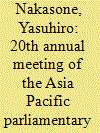

|
|
|
| 2 |
ID:
128428
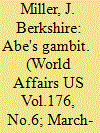

|
|
|
|
|
| Publication |
2014.
|
| Summary/Abstract |
China's aggressive actions in the East China Sea, combined with other factors, especially North Korea's continuing intransigence, have created an increasingly hostile security environment for Japan. Its response to these events can be seen in the impressive political rebirth of Shinzo Abe and the Liberal Democratic Party. While Abe, currently serving as prime minister for a second time, was elected largely because of his economic policies and the ineptitude of the formerly ruling Democratic Party of Japan, he has used his mandate to press forward with long needed, albeit controversial, defense and security reforms that indicate the seriousness with which Tokyo takes its current situation. With China looming up in front of them, and Pyongyang posing lesser but still worrisome threats, the Japanese have become acutely aware of the fact that their Self-Defense Forces (SDF) have one hundred and forty thousand ground troops, one hundred and forty-one maritime vessels, and four hundred and ten aircraft, while China's People's Liberation Army has one million six hundred thousand troops and North Korea has one million soldiers. Meanwhile, North Korea maintains a significant, if decaying, navy and air force, with one hundred and ninety vessels and approximately six hundred aircraft. China's much more capable maritime and air assets include nine hundred and seventy vessels and two thousand five hundred and eighty aircraft.
|
|
|
|
|
|
|
|
|
|
|
|
|
|
|
|
| 3 |
ID:
138289
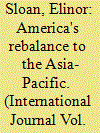

|
|
|
|
|
| Summary/Abstract |
This paper examines the impact of the US pivot to the Asia-Pacific on Canada’s strategic thinking and maritime posture. It highlights elements of the US rebalance before examining Canada’s recent past, present, and future strategic and military engagement. Canada wants to be able to contribute to crisis de-escalation if regional tensions lead to conflict, yet the Royal Canadian Navy has less deployment capacity today than it has had in 25 years. To contribute to mediatory influence, and provide warfighting capability, a recapitalized navy should increase deployments to the region, forward deploy some naval assets, and ensure interoperability with its US counterpart. In the event of a crisis, a choice might have to be made between a neutral, honest-broker stance and a more likely decision to contribute forces to a US-led coalition. The first step in either case is to be in the Asia-Pacific region with capable and credible naval forces.
|
|
|
|
|
|
|
|
|
|
|
|
|
|
|
|
| 4 |
ID:
134019
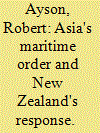

|
|
|
|
|
| Publication |
2014.
|
| Summary/Abstract |
Robert Ayson comments on the South China Sea. Asia's regional security and New Zealand foreign policy
as the powers jostle in a more competitive Asia-Pacific region, it may seem counter-intuitive to call for a clearer New Zealand position on the South China Sea disputes. But even as regional tensions grow, Wellington can stick up for its principles without joining a chorus of China criticism. Under the key government, New Zealand's alignment with the United States is becoming more pronounced through a series of small but cumulatively important steps. this makes it even more important for New Zealand's policy to be staked out clearly, including in written from accessible to the public discussion.
|
|
|
|
|
|
|
|
|
|
|
|
|
|
|
|
| 5 |
ID:
101830
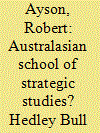

|
|
|
|
|
| Publication |
2011.
|
| Summary/Abstract |
To the extent that there is a distinctively Australasian school of strategic studies it is to be found in the work of Hedley Bull, a scholar who is more widely noted for his work as an international relations theorist. Bull's lesser known but influential contributions to strategic studies dealt with the management of nuclear weapons in international strategic relationships and the management of great power relations in the Asia-Pacific region. His work in these areas, while less well known than some of his other writings, deserves contemporary attention as strategic change in Asia increasingly shapes the international strategic picture, thereby creating the opportunity for Australasian strategic analysts to influence the global debate.
|
|
|
|
|
|
|
|
|
|
|
|
|
|
|
|
| 6 |
ID:
108143
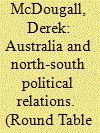

|
|
|
|
|
| Publication |
2011.
|
| Summary/Abstract |
North-South issues as such do not figure prominently in Australia's international policy but are mostly implicit. These issues arise particularly in the context of Australia's relations with countries in its immediate vicinity, including the South Pacific, Indonesia and East Timor. There are also some global issues in the North-South context where Australia is affected. Australian governments, in developing policies relating to this context, have been influenced by a 'practical realism' that puts first priority on Australian interests as perceived by governments at any given time. The way in which those policies have been developed, in both the regional and the global contexts, can be assessed through an examination of issues relating to security and international economic relations. Australia's alliance relationship has a strong bearing on the way Australia approaches the security issues. In relation to international economic issues there are many commonalities with fellow producers of raw materials in the Global South.
|
|
|
|
|
|
|
|
|
|
|
|
|
|
|
|
| 7 |
ID:
098402
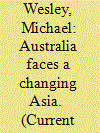

|
|
|
|
|
| Publication |
2010.
|
| Summary/Abstract |
Tensions between Australia's strategic alignment and its economic alignment . . . heighten Canberra's anxieties about having to choose between security and prosperity in the event of a confrontation between the United States and China.
|
|
|
|
|
|
|
|
|
|
|
|
|
|
|
|
| 8 |
ID:
103019
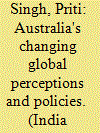

|
|
|
| 9 |
ID:
121669
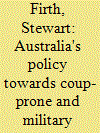

|
|
|
|
|
| Publication |
2013.
|
| Summary/Abstract |
Events in Thailand, Fiji and Burma in 2006 and 2007 focused attention on Australia's foreign policy response to regional coup-prone states and military regimes. Australia's official reaction to these events took different forms: for Thailand, a mild rebuke that brought no change in Thai-Australian relations; for Fiji, condemnation, the imposition of sanctions and a call for the people of Fiji to rebel; and for Burma, a change of policy that brought financial sanctions against the military regime. This article argues that, in responding to these regimes in different ways, Australian governments act on the basis of differing prisms of understanding through which they assess regions and states. The differences ultimately arise from calculations of Australian national security, strategic interests, alliance maintenance and power potential, but tend to be obscured by the universalist rhetoric of promoting democracy and protecting human rights, to which Australian governments subscribe. As the security dynamic in the Asia-Pacific changes as a consequence of the rise of China, Australian policy towards coup-prone states and military regimes in the region is likely to favour stability over democracy or the protection of human rights.
|
|
|
|
|
|
|
|
|
|
|
|
|
|
|
|
| 10 |
ID:
092622
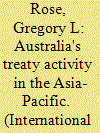

|
|
|
|
|
| Publication |
2009.
|
| Summary/Abstract |
This paper investigates Australian treaty making with neighboring countries in the Asia-Pacific. Patterns of Australian treaty making with South East Asian countries are markedly different to those with South West Pacific countries and the difference is continuing to deepen. Treaties with the former are primarily bilateral and commercially oriented, whereas those with the latter are plurilateral and oriented to natural resources management and development. There is a major gap in Australian subregional treaty activity for natural resources management in South East Asian countries. A coalescence of issues in the law enforcement and security categories is occurring and the new direction in Australian regional treaty making for both subregions is to strengthen capacity to enforce the rule of law in national legal systems. Commercial treaty making remains and is likely to continue to be the strongest area of treaty activity.
|
|
|
|
|
|
|
|
|
|
|
|
|
|
|
|
| 11 |
ID:
115189
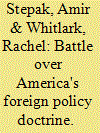

|
|
|
|
|
| Publication |
2012.
|
| Summary/Abstract |
One balmy Washington evening in June 2011, President Barack Obama was set to deliver a highly anticipated address declaring the drawdown of US forces in Afghanistan. What he delivered, however, was much more. In his speech, Obama laid out a clear foreign-policy doctrine, touching on the role the United States should play in world affairs, the values it holds dear, and the principles guiding its use of force and diplomatic efforts. Rejecting the divergent paths of isolationism and expansionism, Obama called for 'a more centered course':
|
|
|
|
|
|
|
|
|
|
|
|
|
|
|
|
| 12 |
ID:
110899
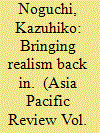

|
|
|
|
|
| Publication |
2011.
|
| Summary/Abstract |
This article argues that offensive realism is applicable to explain China's strategic behavior. Contrary to constructivist and liberal arguments, ideational and domestic factors are not the primary causes of China's strategic behavior. Instead, structural and material factors such as anarchy and the distribution of relative power significantly shape how China behaves in the Asia-Pacific. Furthermore, they have a larger impact relative to non-material/unit-level variables on China's policymaking. Available evidence strongly indicates that China's strategic behavior is driven by power maximizing calculation. China's grand strategy, its maritime ambition as well as naval modernization, and rapid growth rate of military expenditure all confirm the hypotheses of offensive realism.
|
|
|
|
|
|
|
|
|
|
|
|
|
|
|
|
| 13 |
ID:
128418
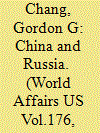

|
|
|
|
|
| Publication |
2014.
|
| Summary/Abstract |
Economic weakness has driven Vladimir Putin's Russia into a "strategic entente" with the Chinese, who in turn get a powerful global ally. The alliance could prove formidable for the West.
|
|
|
|
|
|
|
|
|
|
|
|
|
|
|
|
| 14 |
ID:
096403
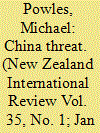

|
|
|
| 15 |
ID:
160694
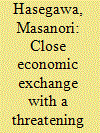

|
|
|
|
|
| Summary/Abstract |
China’s rise presents a daunting dilemma for many Asia-Pacific states. What has not been fully appreciated is that many of China’s neighbors confront the dilemma of “close economic exchange with a threatening state” (CEETS). If they continue CEETS, it strengthens the threatening state’s economic and military power, jeopardizing their security. However, ending CEETS can cause their own economies to decline, deteriorating their national power and destabilizing their governments. Dominant theories such as realism and liberalism have not adequately explained security problems caused by CEETS, its origins, and potential countermeasures against it. This article examines these issues, focusing on the Asia-Pacific. Although there is no single panacea against CEETS dilemma, a regional agreement such as the Trans-Pacific Partnership (TPP) could be a promising countermeasure against it.
|
|
|
|
|
|
|
|
|
|
|
|
|
|
|
|
| 16 |
ID:
091679
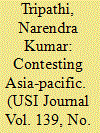

|
|
|
| 17 |
ID:
114746
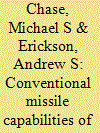

|
|
|
|
|
| Publication |
2012.
|
| Summary/Abstract |
Since its establishment in the early 1990s, the conventional missile component of the People's Liberation Army's Second Artillery Force (SAF) has emerged as a centerpiece of China's accelerating military modernization program. The conventional missile force has grown in size and sophistication, and China has developed a doctrine for its employment. Chinese military publications emphasize that it plays an increasingly important role in deterrence and warfighting. In particular, Chinese sources underscore its role in achieving information dominance, air superiority, and sea control as well as countering third-party intervention. China's development of advanced conventional missile capabilities highlights the growing vulnerability of fixed bases and surface ships. Moreover, organizational tendencies, could fuel dangerous escalation. In response to these challenges, the United States must adapt its traditional approach to military operations and deterrence in the Asia-Pacific.
|
|
|
|
|
|
|
|
|
|
|
|
|
|
|
|
| 18 |
ID:
133694
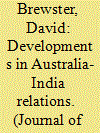

|
|
|
|
|
| Publication |
2014.
|
| Summary/Abstract |
India and Australia have the potential to become important strategic partners in Asia as part of a coalition that could help manage the changing balance of power in the region. But while India and Australia share many strategic interests, both countries still have a lot to learn about how to get along with each other. Some might even see them as the odd couple of the lndo-Paci?c. This paper looks at recent developments in the relationship in the areas of security, politics and economics, and the prospects for a closer partnership under the new Modi government.
|
|
|
|
|
|
|
|
|
|
|
|
|
|
|
|
| 19 |
ID:
120202
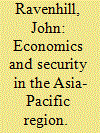

|
|
|
|
|
| Publication |
2013.
|
| Summary/Abstract |
The relationship between economics and security remains relatively unexplored, particularly in the Asia-Pacific context. The articles in this special section of the journal seek to broaden our comprehension of various dimensions of this relationship. One focus is to understand the circumstances in which issues have come to be defined as components of national 'security'. A second is to develop a more nuanced approach to conflict, one that recognizes that interstate conflict can take numerous forms short of the outbreak of military confrontation. Our starting point is to emphasize that 'security' is a social construction: issues become 'securitized' when political actors identify them as posing a threat to national security. The redefinition of national understandings of security by state elites is one instance of how economics and security can become intertwined. Economic competition, however, can generate a second dimension to the economics-security nexus, which occurs when it spills over into the traditional security domain, that is, into military rivalries between states. Our studies provide some grounds for optimism on the relationship between economics and security - albeit one that has to be tempered both by the failure of countries in the region to develop deeply institutionalized means for dispute resolution and by the evidence that economic issues can be a significant source of both interstate and intrastate conflict.
|
|
|
|
|
|
|
|
|
|
|
|
|
|
|
|
| 20 |
ID:
110281
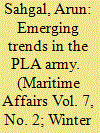

|
|
|
|
|
|
|
|